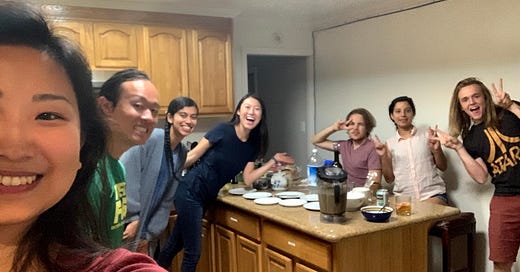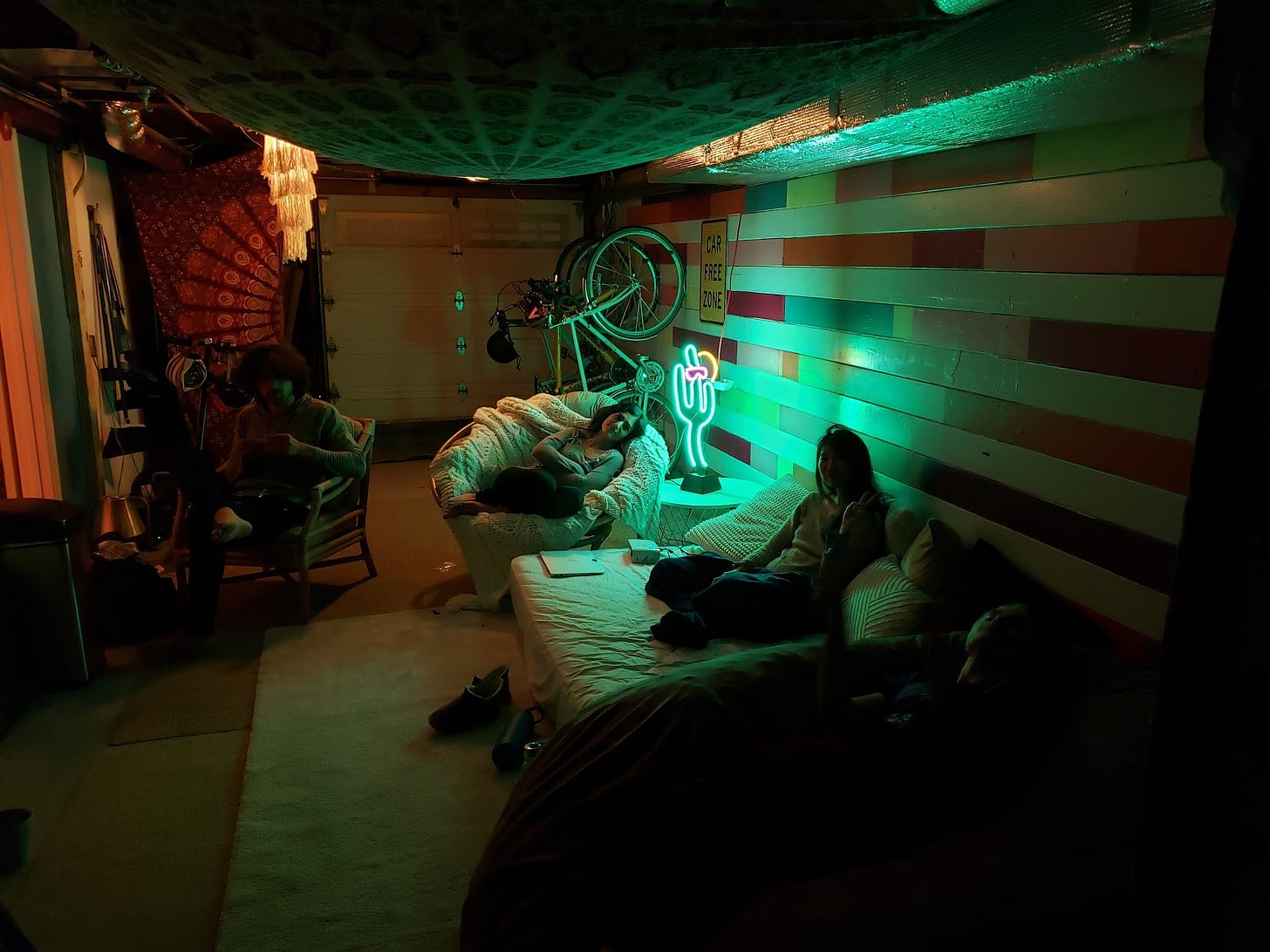Editor’s note: This is a reader-submitted case study from Andrew and Priya, who started Rabbithole, a 7-person community in San Francisco. In the post, they describe their teething period in the first year and the unique challenges presented by Covid. This is part of an ongoing series of deep dives on coliving spaces. To see others, visit the Supernuclear directory.
If you want to contribute a case study of your community, let us know at hi@gosupernuclear.com
Date Founded: February 2020
Rented or owned: Rented
Location: San Francisco
# of people: 7
Governance: Doocracy + general consensus seeking
Food System: Shared groceries
Origins
It was January 2020 -- just a few weeks before the pandemic would hit the States. Priya and I looked over at each other from our tiny bedroom, with its tiny (and painfully dim) window. We knew it was time for something bigger, better, more joyous.
Blissfully ignorant of the impending doom that would fall upon the country in March, we set off to build our first physical community. From the beginning, we dreamed big -- we'd be a hosting space for our friends, a relaxed and warm space for meaningful relationships to form, an open door for a rotating cast of quirky and wonderful guests, a launching pad for future communities...
10 months later, I couldn't be more thankful for what we've built.
The Plan
Every great adventure starts with a plot, so Priya and I began plotting. It felt like a series of questions and answers, the vision coming to life before us as we went deeper down The Rabbithole. I think answering some or all of the following questions will help you form a cohesive vision for your space:
- Q: What core problems are we trying to solve?
- A: Loneliness, social shallowness, lack of "home"
- Q: What sort of social interactions are we trying to cultivate above all else?
- A: Kind, Playful, Odd ones
- Q: What are our core values?
- A: Growth, Play, Kindness, Honesty, Integrity
- Q: How big will the community be?
- A: Small and intimate, just 6-7 people, with a vast, interconnected circle of guests and friends.
- Q: What sort of relationship should members have?
- A: True friends, not just roommates or friend-lite
- Q: How will we govern and make decisions?
- A: We will trust each other to do the right thing (doocracy), with a backup democracy in the event of failure, with backup lease-holder emergency powers in the event of extreme failure.
- Q: How will people enter the community?
- A: Unanimously, unless it poses a significant financial burden on the house
In the end, we drafted a document to solidify and clearly communicate our values for future housemates: I recommend documents like this as artifacts of culture. There are numerous examples online of similar (and more ambitious) house documents. In fact, we took our format, and many of the specifics from Agape house in SF. The CRC anthology is an incredible collection of specific resources, you should study them for wisdom when drafting documents of your own.
We also started searching for co-founders, right away. In my opinion, there's no good reason to wait -- this isn't a business proposal, it's a labor of love, and your future co-creators will appreciate being included from the very beginning. It's okay if the vision feels a little messy, incomplete, or rough around the edges. Early founders of a community actually like that so they can help shape it.
The Struggle to Stability
Our path to a warm and stable home was rocky, with unexpected twists from the very beginning.
The first two weeks were a wild adventure. We had just signed a year-long lease and were ready to build the community of our dreams! It was a frantic and cooperative race to find second-hand furniture, decorate the house, move everyone out of their old places, set up financial and communication systems, and prepare the house to be the community space we imagined.
But just around the corner was the biggest (and cruelest) twist we would face -- the pandemic. San Francisco issued their shelter-in-place order in early March, just after we'd finished moving in.
Due to the pandemic, one of our housemates decided to move out to be with friends and family. Another was never able to move in at all, due to shelter-in-place orders while living with her partner. Another asked if her boyfriend could shelter with her (this would turn out to be a costly mistake, as their relationship dynamics would come to be a major source of tension in the house). A fourth decided he couldn't stay cooped up forever, and decided to take a cross country road trip for the next few months.
Over the course of the first 5 months, we cycled through a total of 13 different housemates, most of them short-term sublets. Maintaining the original culture and sticking to our values was a constant struggle, and filling the house was a consistent source of stress for the lease-holders. Priya and I would frequently go on walks to clear our heads, and sort through all of our logistical concerns -- our mutual support was a necessary lifeline. This struggle for survival shaped the early days.
Coliving through a pandemic
We knew that group buy-in and governance issues are hard problems for any community, but COVID upped the stakes for collective rule-setting dramatically. At this time, the risk of COVID was so unknown that it isn't an exaggeration to say we were quite literally discussing life and death decisions. Obviously doocracy was not going to work for this.
For a community so young, and in so much flux, navigating the risks of COVID-19 was treacherous and stressful -- tensions were high. Are we allowed to go outside, to go for runs, to go to parks? How do we fill empty rooms without exposing ourselves? Can we ask roommates to quarantine? How do we convince, and then vet, people to join the community without being able to meet each other? Negotiating these concerns was stressful, and necessitated a balancing of personal safety, financial risk, community strength, and mental health.
Here's what we learned:
It's important to have conversations early and often. Don't avoid discussing COVID.
Don't let governance disagreements stretch too long. Sometimes there are issues where no amount of continued discussion will lead to happy resolution. The conversation starts circling. In these moments, either table the conversation, or vote and be done with it.
For issues of life and death, you must lean strongly toward the most concerned voice. Either majority rule or "averaging" risk tolerance are not good enough, because of asymmetric costs. If you are too liberal, the concerned have to live in paranoia and fear of their own housemates. This is a bigger cost than the inconvenience of forgoing some activities.
You must be able to see friends and leave the house, somehow. No matter how we tried to avoid it, mental health deteriorated rapidly if we weren't able to see our friends and go on small adventures. Do what it takes to make these small indulgences feel safe for all.
Ask your landlord for help. Our landlord was generous enough to give us 3 months of leeway on one of our rooms, which gave us enough of a financial buffer to avoid losses.
On the other side
Finally, around September, we locked in the current cohort. Now, in early November, I can feel the house blossoming -- as if the hardest trials are over, and the true spirit (the playful, kind, optimistic spirit) is finally able to emerge. The pandemic isn't over, and co-living logistics during this era are still a constant trial, but the whole tone feels different -- we're resolved to solve the problems together, for each other, instead of alone, for ourselves. There's a level of commitment to The Rabbithole that previously wasn't there.
One valuable lesson I learned is that you can't give a group their "why". The "why" emerges naturally from the group, or the group falls apart. No official documentation of house values can prevent this. Opting into a community is opting into a shared "why" -- a shared reason for being together.
A "why" is hard to put into words, but if I had to, I'd say ours is: "Because going through this hard time is better together. Because we want to have fun together. Because we want to befriend one another."
Your "why" will be different.
Lessons learned:
1. To get through hard times, you must have consistent rituals that bring the house together. For us, this was dinner, which we would share frequently.
2. Meetings suck -- handle as many logistical things asynchronously as possible. Official meetings are occasionally necessary, but often stressful. Replace meetings with leisure time, spent together.
3. Take pictures, take videos, make art. Cultural artifacts are a priceless record of your time together. You will wish you had more.
(from Phil and Gillian) Thanks to Andrew and Priya for sharing their story! If you’ve lived in a community, would you be willing to share a bit about it here? We might follow up with you to produce more posts like this <3
Curious about coliving? Find more case studies, how tos, and reflections at Supernuclear: a guide to coliving. Sign up to be notified as future articles are published here:
No spam, just the good stuff.
You can find the directory of the articles we’ve written and plan to write here.










So stupid this whole thing isn’t some innovative community as it’s described - call it co living if you must - but it’s called ROOMMATES. Duh, whatever.